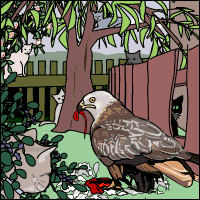Red Kites - Birds of Prey
Created | Updated Nov 2, 2008

My heart in hiding
Stirred for a bird, - the achieve of, the mastery of the thing!
Brute beauty and valour and act, oh, air, pride, plume, here
Buckle!
- Gerard Manley Hopkins (1844 - 1889), 'The Windhover'
A red kite descends into an English suburban garden and starts picking over the carcass of a freshly killed wild dove. It isn't clear whether the dove was killed by the kite or by one of the local domestic cats. The cats remain warily present, hidden behind garden fences while the kite gorges itself. They seem unsure what to make of the bird, which is probably a lot larger than any of them have ever encountered before. Then suddenly the kite takes off with its booty.
The kite (Milvus milvus) is a bird of prey native to the British Isles. It is a member of the hawk family, so it is related to the osprey, sparrowhawk, buzzard, golden eagle and the harriers.
Until the 18th Century kites were widespread over Britain. They were common scavengers in the streets of medieval and Elizabethan London. Shakespeare refers to the kite's prowess as a scavenger when he has Hamlet say:
But I am pigeon-livered, and lack gall
To make oppression bitter, or ere this
I should have fatted all the region's kites
With this slave's offal.
Unfortunately, by the end of the 19th Century they had become extinct in England and were confined to a remote area in the hill country of central Wales.
In the early 1990s, however, kites were re-introduced, with great success. They have now become a frequent, even common, sight in certain areas, notably in The Chilterns (an officially designated Area of Outstanding Natural Beauty not far from London), the Midlands, Yorkshire, and parts of Scotland and Wales. In the town of High Wycombe, Buckinghamshire, for example, kites are occasionally seen swooping over the town, gardens and playing fields near the residential areas.
Kites in Flight
Kites are superb fliers, soaring on updraughts and able to circle tirelessly for many hours over wooded valleys or, indeed, housing estates. They have long, slender wings, splayed at the wingtips and usually bent backwards at the 'wrist'. They steer by means of a long and distinctively forked tail. They seem to be able to soar, glide and tumble through the air quite effortlessly, and will also swoop and pounce very quickly for a sudden kill.
Males have rusty brown plumage with a streaked white head and a slender body. Females are slightly duller. Their call has been described as a shrill, mewing 'weeou-weeou-weeou'.
Because of their impressive flying skills they have given their name to the children's toy on a long string.
Courtship
As with other birds of prey, kites will often enjoy giving diving displays. During the courtship ceremony pairs of kites will join in various aerobatics.
Nesting
Both sexes help build the nest out of sticks and earth. It will be located in a tree, often using the site of an old nest of a crow. Kites' nests are bulky, and as well as being bound together with mud they will often be lined with wool, moss, hair, and even paper or cloth. Shakespeare, keen naturalist that he was, was well aware of this tendency of kites, and even warns in The Winter's Tale:
When the kite builds, look to lesser linen.
The female will lay usually two or three eggs, in April or May. They are white, speckled with reddish brown, and will incubate in about 30 days. The nestlings, who are looked after by both parents, will be ready to leave the nest in about 50 days or so.
Feeding
Kites feed mostly on carrion or road kill, but will attack small prey if necessary. Live prey include worms and insects, fledgling crows, gulls and pigeons, and rabbits, but nothing larger.
One reason the kite was hunted to extinction is that for many years farmers mistakenly believed they would attack and kill lambs. But while they will feed on animals that are already dead, they will not attack live animals of this size.
Another cause of their virtual extinction was the fondness of the Victorians for killing and stuffing animals and displaying them in glass cases rather than enjoying them in the wild.
Protection and Conservation
Nowadays, thanks to the efforts of conservationists and The Royal Society for the Protection of Birds, kites are flourishing once again. They are a protected species, and the locations of nesting sites are a carefully guarded secret, for there are still those who prefer to traffic in natural objects of beauty such as rare eggs, rather than respect them for what they are.
Attitudes have generally improved a lot since the Victorian age, however, and society does not tolerate that sort of thing so much now. Kites appear to have a bright future!

